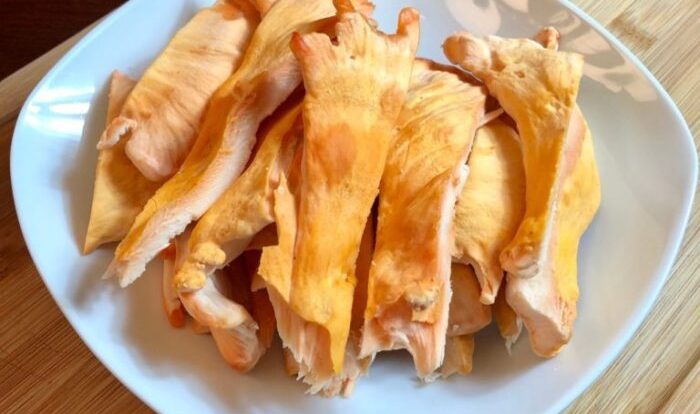
Embark on a culinary adventure with our enticing chicken of the woods recipe. Discover the versatile nature of this woodland treasure, from its tantalizing flavors to its impressive nutritional value.
Whether you’re a seasoned chef or a curious home cook, this guide will equip you with everything you need to know about foraging, cooking, and savoring this delectable delicacy.
Recipe Variations
Chicken of the woods is a versatile mushroom that can be prepared in a variety of ways. Here are some popular cooking methods and how they affect the flavor and texture of the mushroom:
Sautéed
- Sautéing chicken of the woods in butter or oil is a quick and easy way to cook it. This method results in a tender and flavorful mushroom with a slightly crispy exterior.
- To sauté chicken of the woods, simply heat some butter or oil in a skillet over medium heat. Add the mushrooms and cook until they are browned and tender, about 5-7 minutes. Season with salt and pepper to taste.
Grilled
- Grilling chicken of the woods is a great way to get a smoky flavor. This method is also relatively quick and easy, and it results in a tender and juicy mushroom.
- To grill chicken of the woods, simply preheat your grill to medium-high heat. Brush the mushrooms with olive oil and season with salt and pepper. Grill the mushrooms for 5-7 minutes per side, or until they are cooked through.
Roasted
- Roasting chicken of the woods is a great way to get a caramelized flavor. This method is a bit more time-consuming than sautéing or grilling, but it results in a flavorful and tender mushroom.
- To roast chicken of the woods, simply preheat your oven to 400 degrees Fahrenheit. Toss the mushrooms with olive oil and season with salt and pepper. Roast the mushrooms for 15-20 minutes, or until they are browned and tender.
Fried
- Frying chicken of the woods is a great way to get a crispy exterior. This method is a bit more labor-intensive than the other methods, but it results in a delicious and addictive snack.
- To fry chicken of the woods, simply heat some vegetable oil in a large skillet over medium heat. Dip the mushrooms in a batter made from flour, eggs, and milk. Fry the mushrooms for 2-3 minutes per side, or until they are golden brown and cooked through.
Culinary Applications

Chicken of the woods is a versatile culinary ingredient that can be used in a wide variety of dishes. Its unique flavor and texture make it a great addition to soups, stews, salads, and pasta dishes. It can also be grilled, roasted, or fried.
Pairing with Other Ingredients and Flavors
Chicken of the woods pairs well with a variety of ingredients and flavors. It can be combined with other mushrooms, vegetables, meats, and cheeses. It is also a good source of umami, which can enhance the flavor of other dishes.
Creative Ideas for Incorporating Chicken of the Woods
Here are some creative ideas for incorporating chicken of the woods into your meals:
- Add it to a vegetarian or vegan chili for a meaty flavor.
- Use it as a topping for pizza or pasta.
- Grill it and serve it with a dipping sauce.
- Roast it with vegetables for a flavorful side dish.
- Sauté it with garlic and herbs for a quick and easy side dish.
Nutritional Value

Chicken of the woods is a nutritional powerhouse, offering a wealth of essential nutrients. It’s an excellent source of protein, boasting a higher protein content than many other mushrooms. This protein is crucial for building and repairing tissues, producing enzymes and hormones, and supporting overall body functions.
Additionally, chicken of the woods is rich in dietary fiber, which promotes digestive health, satiety, and blood sugar regulation. It’s also a good source of vitamins and minerals, including vitamin D, potassium, phosphorus, and iron. Vitamin D is essential for bone health, potassium supports heart function, and phosphorus is involved in energy metabolism.
Potential Health Benefits
- Immune System Support:Chicken of the woods contains polysaccharides that have immune-boosting properties.
- Antioxidant Activity:It’s a good source of antioxidants that help protect cells from damage caused by free radicals.
- Cholesterol Reduction:Some studies suggest that consuming chicken of the woods may help lower cholesterol levels.
Foraging and Identification
Embarking on a foraging adventure for chicken of the woods requires a keen eye and responsible practices. Here’s a guide to help you identify and sustainably harvest this culinary treasure.
Have you ever tried a chicken of the woods recipe ? This unique mushroom, also known as Laetiporus sulphureus, has a meaty texture and a savory flavor that make it a popular substitute for chicken in vegetarian dishes. Whether you’re looking for a vegan option or simply want to experiment with new flavors, this recipe is sure to impress.
Identifying Chicken of the Woods
- Color and Texture:Look for bright orange to yellow shelves with a velvety texture and a ruffled, feathery appearance.
- Shape and Size:They typically grow in clusters, forming overlapping shelves up to 12 inches wide.
- Spore Surface:The underside of the shelves has tiny pores, rather than gills.
Distinguishing from Similar Mushrooms
- False Chicken of the Woods (Laetiporus sulphureus):Similar in appearance, but its shelves are more rigid and have larger pores.
- Chicken of the Woods Lookalike (Maitake):Also orange, but has ruffled edges and clusters that form a ball-like shape.
- Sulphur Shelf (Laetiporus conifericola):Grows on conifers and has a more yellowish color.
Responsible Foraging Practices
Respect the ecosystem by following these guidelines:
- Harvest only what you need and leave some for wildlife.
- Avoid collecting from polluted areas or near roads.
- Cut mushrooms cleanly at the base to prevent damage.
- Identify mushrooms with certainty before consuming them.
Culinary History and Cultural Significance: Chicken Of The Woods Recipe
Chicken of the woods has a rich culinary history dating back centuries. Its distinctive flavor and meaty texture have made it a popular ingredient in various cuisines worldwide.
If you’re interested in trying a different variation, check out the chicken of the woods recipe from Alameda. This version includes a flavorful marinade made with soy sauce, garlic, and ginger, giving the mushrooms an extra layer of umami.
Europe
In Europe, chicken of the woods has been consumed for centuries, particularly in Eastern European countries like Russia, Ukraine, and Poland. It is often used in soups, stews, and dumplings. In France, it is known as “grifola frondosa” and is prized for its use in sauces and pâtés.
Asia
In Asia, chicken of the woods is widely used in Chinese, Japanese, and Korean cuisine. In China, it is called “huáng mó gū” and is often cooked with vegetables or in soups. In Japan, it is known as “maitake” and is used in tempura, stir-fries, and soups.
North America, Chicken of the woods recipe
Native American tribes in North America have traditionally used chicken of the woods as a food source. They would often dry and store it for later use during the winter months. In recent years, it has gained popularity in American cuisine, where it is often used in soups, stews, and salads.
End of Discussion

As you explore the culinary delights of chicken of the woods, remember its significance beyond the plate. Embrace the joy of foraging, appreciate its cultural heritage, and indulge in the health benefits it offers. Let this recipe be your gateway to a world of culinary exploration and appreciation.
FAQs
How can I identify chicken of the woods?
Look for bright orange, shelf-like mushrooms with a velvety texture. They typically grow on fallen logs or dead trees.
What’s the best way to cook chicken of the woods?
Sautéing, grilling, roasting, or frying are all great options. Each method imparts unique flavors and textures.
Is chicken of the woods safe to eat raw?
No, it’s recommended to cook chicken of the woods thoroughly to avoid any potential digestive issues.




